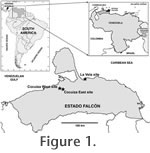Introduction
Studies of fossil echinoids in Venezuela have been sporadically conducted in past decades, resulting in records from the Permian to the Neogene (Jeannet 1928;
Cooke 1941;
Von der Osten 1957;
Cooke 1961;
Anisgard 1954;
Weisbord 1969;
Hoover 1981;
Mooi and Peterson 2000). In spite of the limitations resulting from the low sample sizes, some patterns in echinoid ecology and evolution in this country are recognizable. There are about 2,800 km of coast line in Venezuela, and this vast area is particularly relevant for understanding changes in the Caribbean echinoid assemblages in the last portion of the Cenozoic period. However, one has to be aware that Venezuela plays a special ecological role in the Caribbean because of seasonal upwelling, a phenomenon otherwise absent or less important in the rest of the Caribbean. Our material comes from the Late Miocene to the Early Pleistocene which was the time around the closure of the Central American Isthmus, when major changes in marine environments occurred (Lessios 2008).
 The new fossil material was collected by M.R. Sánchez-Villagra, O. Aguilera and associates mostly in June of 2008 from three localities in Falcón State in north-western Venezuela (Figure 1). This savannah-like region contains outcrops of mostly Neogene deposits (Johnson et al. 2009). At two of our fossil sites (Cocuiza West: N 11°18'38.4'' N 70°14'26.2'' and Cocuiza East: N 11°18'37.8'' W 70°14'21.2''), sediments of the Cocuiza Member of the San Gregorio Formation are exposed, and at the third fossil site (La Vela: N 11°30'0.2'' W 69°31'50''), the La Vela Formation crops out. The new fossil material was collected by M.R. Sánchez-Villagra, O. Aguilera and associates mostly in June of 2008 from three localities in Falcón State in north-western Venezuela (Figure 1). This savannah-like region contains outcrops of mostly Neogene deposits (Johnson et al. 2009). At two of our fossil sites (Cocuiza West: N 11°18'38.4'' N 70°14'26.2'' and Cocuiza East: N 11°18'37.8'' W 70°14'21.2''), sediments of the Cocuiza Member of the San Gregorio Formation are exposed, and at the third fossil site (La Vela: N 11°30'0.2'' W 69°31'50''), the La Vela Formation crops out.
The Cocuiza Member constitutes the middle portion of the San Gregorio Formation and is 80 m thick at its type section. This section is characterized by the presence of numerous conspicuous fossil beds separated by siltstones. The fossiliferous beds are usually sandy and unconsolidated to slightly lithified. Palaeoenvironmental reconstructions are based mostly on ostreid-colonies and crustacean burrows and suggest a low to moderate wave energy coastline environment with local occurrence of terrigenous sediments and local sea-level fluctuations (Aguilera et al. 2010). The age of this member is estimated to be of Late Pliocene to Early Pleistocene age (Ministerio de Energía y Minas 1997).
The La Vela Formation is exposed in the Coro-La Vela region in the north-northeastern area of the Falcón Basin. Stratigraphically, it lies above the Taratara Member of the Caujarao Formation. The La Vela Formation is characterized by sandy siltstones and blue-grey shales that are interrupted by sandstone beds. Foraminiferan assemblages suggest a middle neritic habitat (30-60 m deep). The age of this formation is estimated to be Late Miocene to Pliocene (Smith 2008).
Here, we document the taxonomy of new echinoid material, discuss palaeoecological differences among fossil localities and compare the diversity pattern of the echinoid fossil record of Venezuela with that of the entire Caribbean. All specimens are stored in the collection of Universidad Nacional Experimental Francisco de Miranda in Venezuela.
|